The Sandy Bridge Review: Intel Core i7-2600K, i5-2500K and Core i3-2100 Tested
by Anand Lal Shimpi on January 3, 2011 12:01 AM ESTGaming Performance
There's simply no better gaming CPU on the market today than Sandy Bridge. The Core i5 2500K and 2600K top the charts regardless of game. If you're building a new gaming box, you'll want a SNB in it.
Our Fallout 3 test is a quick FRAPS runthrough near the beginning of the game. We're running with a GeForce GTX 280 at 1680 x 1050 and medium quality defaults. There's no AA/AF enabled.
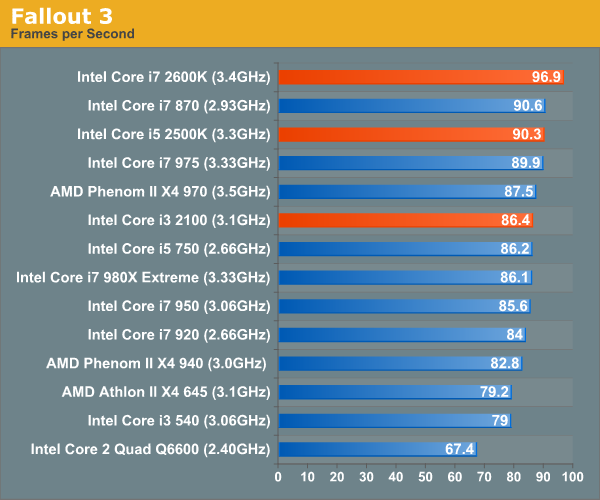
In testing Left 4 Dead we use a custom recorded timedemo. We run on a GeForce GTX 280 at 1680 x 1050 with all quality options set to high. No AA/AF enabled.

Far Cry 2 ships with several built in benchmarks. For this test we use the Playback (Action) demo at 1680 x 1050 in DX9 mode on a GTX 280. The game is set to medium defaults with performance options set to high.
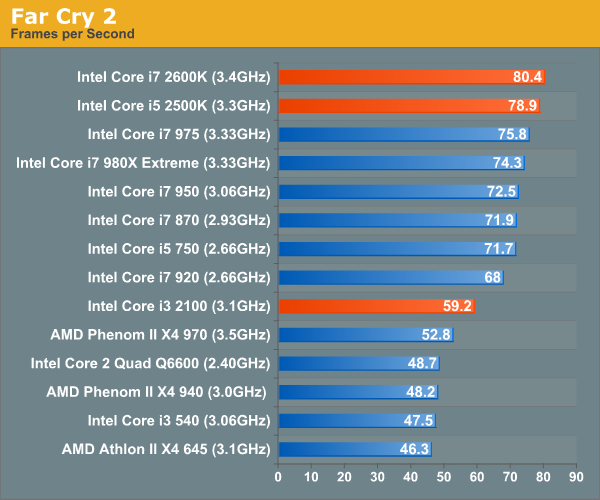
Crysis Warhead also ships with a number of built in benchmarks. Running on a GTX 280 at 1680 x 1050 we run the ambush timedemo with mainstream quality settings. Physics is set to enthusiast however to further stress the CPU.
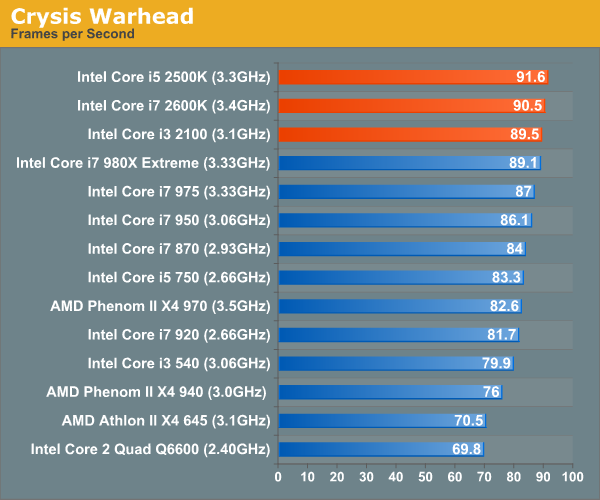
Our Dragon Age: Origins benchmark begins with a shift to the Radeon HD 5870. From this point on these games are run under our Bench refresh testbed under Windows 7 x64. Our benchmark here is the same thing we ran in our integrated graphics tests - a quick FRAPS walkthrough inside a castle. The game is run at 1680 x 1050 at high quality and texture options.
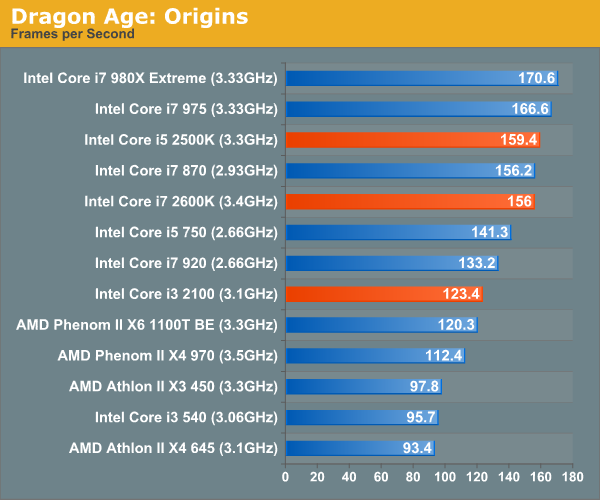
We're running Dawn of War II's internal benchmark at high quality defaults. Our GPU of choice is a Radeon HD 5870 running at 1680 x 1050.
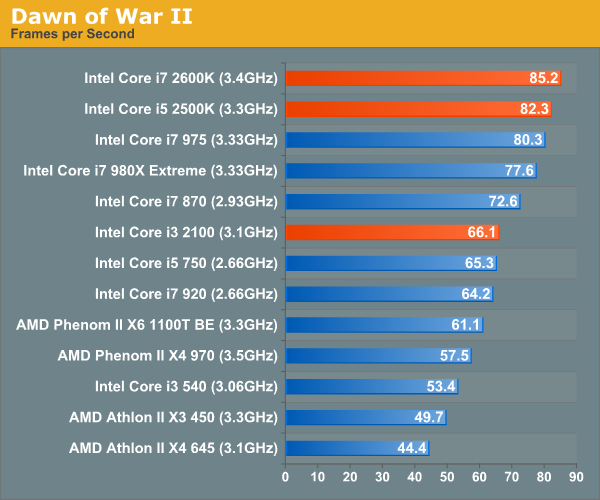
Our World of Warcraft benchmark is a manual FRAPS runthrough of a lightly populated server with no other player controlled characters around. The frame rates here are higher than you'd see in a real world scenario, but the relative comparison between CPUs is accurate.
We run on a Radeon HD 5870 at 1680 x 1050. We're using WoW's high quality defaults but with weather intensity turned down all the way.
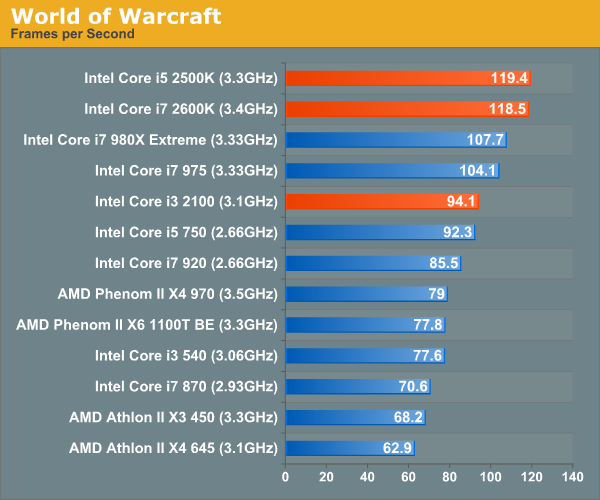
For Starcraft II we're using our heavy CPU test. This is a playback of a 3v3 match where all players gather in the middle of the map for one large, unit-heavy battle. While GPU plays a role here, we're mostly CPU bound. The Radeon HD 5870 is running at 1024 x 768 at medium quality settings to make this an even more pure CPU benchmark.
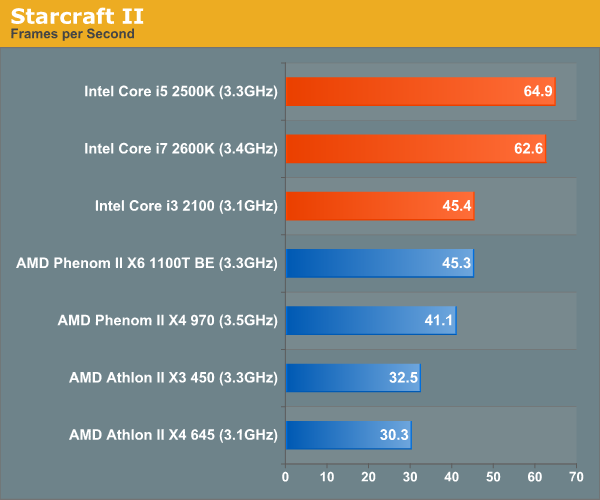
This is Civ V's built in Late GameView benchmark, the newest addition to our gaming test suite. The benchmark outputs three scores: a full render score, a no-shadow render score and a no-render score. We present the first and the last, acting as a GPU and CPU benchmark respectively.
We're running at 1680 x 1050 with all quality settings set to high. For this test we're using a brand new testbed with 8GB of memory and a GeForce GTX 580.
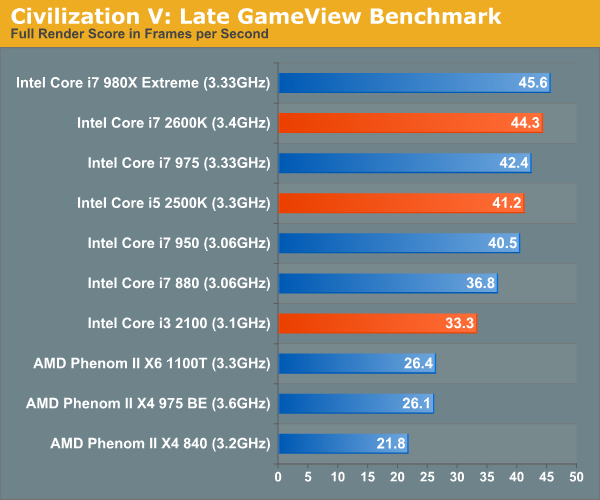
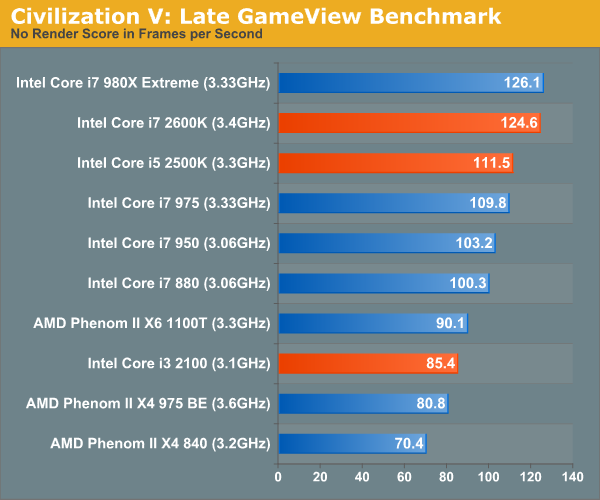










283 Comments
View All Comments
-=Hulk=- - Monday, January 3, 2011 - link
That's crazy, are the chipsets PCI-e line still limited to v1 (250MB/s) speed or what????http://images.anandtech.com/reviews/cpu/intel/sand...
mino - Monday, January 3, 2011 - link
No, you read it wrong.There are altogether 8 PCIE 2.0 linex and all can be used independently, aka s as "PCIe x1".
The CPU-Chipset bandwith however is a basic PCIe x4 link, so do not expect wonders is more divices are in heavy use ...
-=Hulk=- - Monday, January 3, 2011 - link
No!Look at the PCI-e x16 from the CPU. Intel indicates a bandwidth of 16GB/s per line. That means 1GB/s per line.
But PCI-e v2 has a bandwidth of 500MB/s per line only. Thats mean that the values that Intel Indicates for the PCI-e lines are the sum of the upload AND download bandwidth of the PCI-e.
Thats means that the PCI-e lines of the chipset run at 250MB/s speed! That is the bandwidth of the PCI-e v1, and Intel has done the same bullshit with the P55/H57, he indicates that they are PCI-e v2 but they limits their speed to the values of the PCI-e v1:
P55 chipset (look at the 2.5GT/s !!!) :
"PCI Express* 2.0 interface:
Offers up to 2.5GT/s for fast access to peripheral devices and networking with up to 8 PCI Express* 2.0 x1 ports, configurable as x2 and x4 depending on motherboard designs.
http://www.intel.com/products/desktop/chipsets/p55... "
P55, also 500MB/s per line as for the P67
http://benchmarkreviews.com/images/reviews/motherb...
Even for the ancient ICH7 Intel indicates 500MB/s per line, but at that time PCI-e v didn't even exist... That's because it's le sum of the upload and download speed of the PCI-e v1.
http://img.tomshardware.com/us/2007/01/03/the_sout...
DanNeely - Monday, January 3, 2011 - link
Because 2.0 speed for the southbridge lanes has been reported repeatedly (along with a 2x speed DMI bus to connect them), my guess is an error when making the slides with bidirectional BW listed on the CPU and unidirectional BW on the southbridge.jmunjr - Monday, January 3, 2011 - link
Intel's sell out to big media and putting DRM in Sandy Bridge means I won't be getting one of these puppies. I don't care how fast it is...Exodite - Monday, January 3, 2011 - link
Uh, what exactly are you referencing?If it's TXT it's worth noting that the interesting chips, the 2500K and 2600K, doesn't even support it.
chirpy chirpy - Tuesday, January 11, 2011 - link
I think the OP is referring to Intel Insider, the not-so-secret DRM built into the sandy bridge chips. I can't believe people are overlooking the fact that Intel is attempting to introduce DRM at the CPU level and all everyone has to say is "wow, I can't WAIT to get one of dem shiny new uber fast Sandy Bridges!"I for one applaud and welcome our benevolent DRM overlords.....
http://www.pcmag.com/article2/0,2817,2375215,00.as...
nuudles - Monday, January 3, 2011 - link
I have a q9400, if I compare it to the 2500K in bench and average (straight average) all scores the 2500K is 50% faster. The 2500K has a 24% faster base clock, so all the architecture improvements plus faster RAM, more cache and turbo mode gained only ~20% or so on average, which is decent but not awesome taking into account the c2q is 3+ year old design (or is it 4 years?). I know that the idle power is significantly lower due to power gating so due to hurry up and wait it consumes less power (cant remember c2q 45nm load power, but it was not much higher than this core 2011 chips).So 50%+ faster sounds good (both chips occupy the same price bracket), but after equating clock speeds (yes it would increase load and idle power on the c2q) the improvement is not massive but still noticeable.
I will be holding out for Bulldozer (possibly slightly slower, especially in lightly threaded workloads?) or Ivy Bridge as mine is still fast enough to do what I want, rather spend the money on adding a SSD or better graphics card.
7Enigma - Monday, January 3, 2011 - link
I think the issue with the latest launch is the complete and utter lack of competition for what you are asking. Anand's showed that the OC'ing headroom for these chips are fantastic.....and due to the thermals even possible (though not recommended by me personally) on the stock low-profile heatsink.That tells you that they could have significantly increased the performance of this entire line of chips but why should they when there is no competition in sight for the near future (let's ALL hope AMD really produces a winner in the next release) or we're going to be dealing with a plodding approach with INTEL for a while. In a couple months when the gap shrinks (again hopefully by a lot) they simply release a "new" batch with slightly higher turbo frequencies (no need to up the base clocks as this would only hurt power consumption with little/no upside), and bam they get essentially a "free" release.
It stinks as a consumer, but honestly probably hurts us enthusiasts the least since most of us are going to OC these anyways if purchasing the unlocked chips.
I'm still on a C2D @ 3.85GHz but I'm mainly a gamer. In a year or so I'll probably jump on the respin of SDB with even better thermals/OC potential.
DanNeely - Monday, January 3, 2011 - link
CPUs need to be stable in Joe Sixpack's unairconditioned trailer in Alabama during August after the heatsink is crusted in cigarette tar and dust, in one of the horrible computer desks that stuff the tower into a cupboard with just enough open space in the back for wires to get out; not just in an 70F room where all the dust is blown out regularly and the computer has good airflow. Unless something other than temperature is the limiting factor on OC headroom that means that large amounts of OCing can be done easily by those of us who take care of their systems.Since Joe also wants to get 8 or 10 years out of his computer before replacing it the voltages need to be kept low enough that electromigration doesn't kill the chip after 3 or 4. Again that's something that most of us don't need to worry about much.